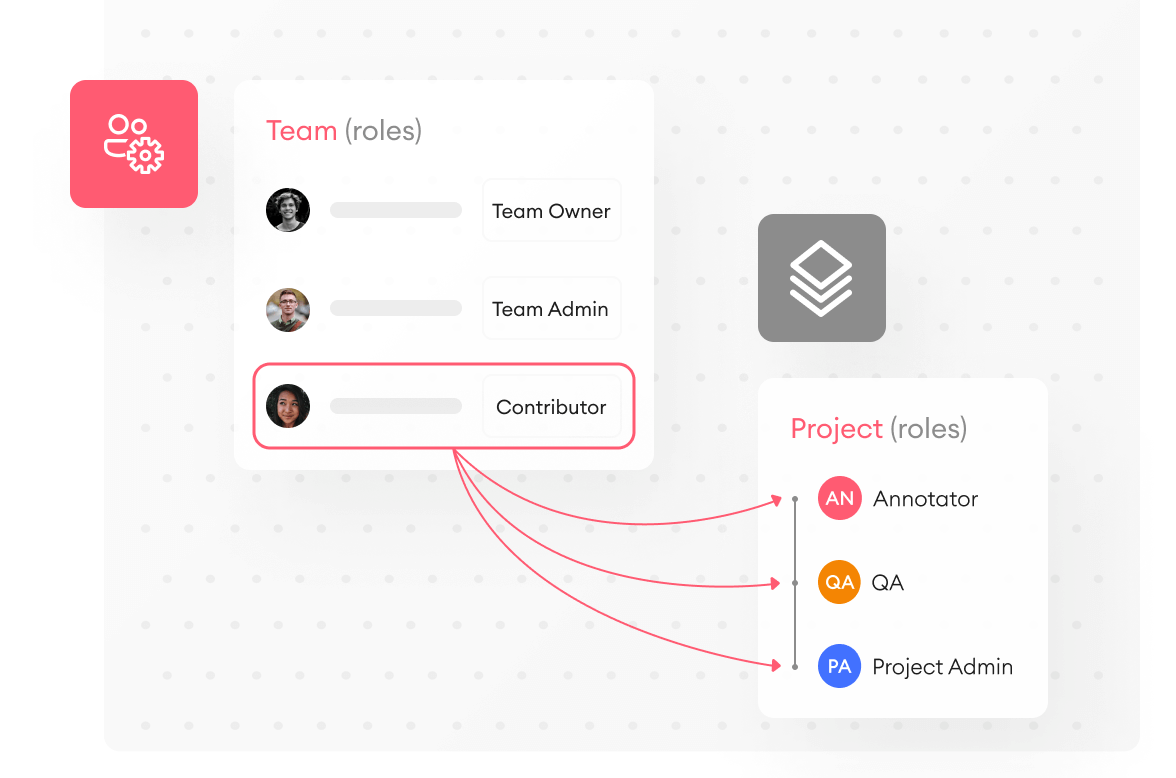Create a project
A team member can have one of the following roles: Team Owner, Team Admin, or Contributor. Team Owners and Team Admins have access to all their team’s projects. When you want to add a contributor to your project, you should assign them to one of the following roles: Annotator, QA, and Project Admin. Learn more about project permissions.

Create a project
To create a project:
- In the Projects tab, click New Project.
- Choose the project type: Multimodal, Image, Image (Legacy), Video or Audio, Text, Tiled Imagery (Beta), or Point Cloud (Beta).
- Type your project’s name.
- Next, you may select a workflow from any that are available for the team (found under Team Setup) to represent the project's annotation life cycle. This is only applicable to the Multimodal, Image, Video, Text, and Tiled Imagery project types.
- There's an additional step for some project types:
- Multimodal - You may enable the Item Category feature to be able to add categories to your items. This can be used to filter, curate, and assign tasks by category. Next, you can choose to create your form from scratch, or by selecting an existing template and working on that.
- Image - You can choose to enable Annotate Similar, which will run an embedding generation on your items as you import them, and allow you to make use of the Annotate Similar feature in the Explore tab.
- Video or Audio - You can choose to enable Frame mode to move through the video(s) or video(s) frame by frame. When you enable Frame mode, you need to enter an FPS.
- Click Create.
Project limitEach team can only have up to 2000 projects created at a time.
SDK functions
Feature compatibilityIf you want to incorporate Python SDK functions into a project with a custom workflow, make sure you use the following python version or higher:
4.4.25
To create a project:
sa.create_project(
project_name = "Project Name",
project_description = "Project Description",
project_type = "Vector"
)To create a Video or Audio Project and set the frame rate:
sa.create_project(
project_name = "Project Name",
project_description = "Project Description",
project_type = "Video",
settings = [{"attribute": "FrameRate", "value": 24}]
)Project types
Multimodal Projects
With Multimodal projects, you can train your LLM model using a form that you can customize to suit your needs. Using our UI builder, you can select components to build your form out of and design the layout. Afterward, you can edit their functionality in the Code Editor and test it out in a preview. Once it’s done, you can generate them into a number of items that can then be used to train your model.
Image Projects
Choose Image if you want to complete object detection projects. The tools in Image projects include Points, Polyline, Polygon, Bounding Box, Ellipse, Cuboid, and many more.
Image (Legacy) Projects
Choose Image (Legacy) if you want to complete semantic and instance segmentation projects. The tools in Image (Legacy) Projects include Polygon, Brush, Box, and Ellipse.
Video or Audio Projects
With Video or Audio projects, you can annotate videos with Bounding Boxes, track objects over the timeline, detect events, add tags, and more.
Warnings and limitations for Video Projects
- Make sure that the value of the FPS matches the FPS of the video(s) you want to upload.
- If your video has a dynamic frame rate or is corrupted, then your annotations won’t be accurate.
- Note that you won’t be able to change the mode once you’ve created the project.
Text Projects
With Text Projects, you can annotate texts for named-entity recognition (NER), use simple and nested tags for text classification, and more.
Tiled Imagery (Beta)
With the Tiled Imagery Editor, you can upload and annotate multilayered images. You can also still do that in the Image Editor. A multilayered image is an image that consists of multiple layers. Think of it as several images combined into one image. You might need to work with multilayered images when you need several references of the same image to achieve higher annotation accuracy. This is applicable for annotating aerial and satellite imagery. For instance, you can upload an image consisting of 3 layers: SAR (synthetic aperture radar imagery), IR (infrared satellite imagery), and RGB.
Point Cloud (Beta)
You’ve read that right! SuperAnnotate now has a Point Cloud Editor (LiDar)! You can get a detailed view of your 3D point data and create accurate annotations for even the most challenging use cases.
Only Image projects and Image (Legacy) projects have the Steps functionality.
Updated 9 months ago